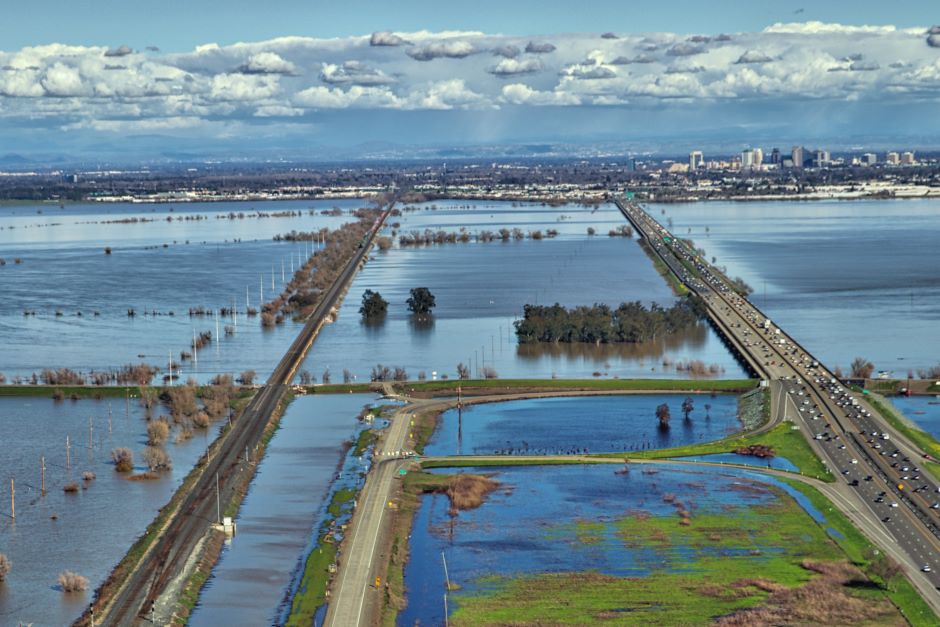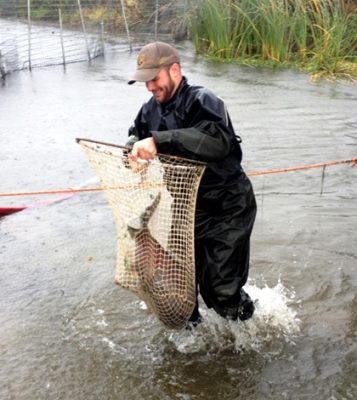Making California’s Yolo Bypass Salmon-Friendly
 Looking towards the city of Sacramento, the Yolo Bypass is pictured (Credit: Steve Martarano / USFWS via Flickr CC BY 2.0)
Looking towards the city of Sacramento, the Yolo Bypass is pictured (Credit: Steve Martarano / USFWS via Flickr CC BY 2.0)Californian salmon have been migrating up and down the west coast for centuries. However, as the region has continued to grow and develop, some of the avenues and routes previously relied on for travel are no longer easy to navigate. Instead, there are complex waterways like the Yolo Bypass, which is comprised of multiple channels and a surrounding floodplain that protects Sacramento from flooding but also creates barriers for migratory fish like salmon.
Adult salmon that are traveling upstream to spawn often don’t make it past the Yolo Bypass due to drought cutting off access points and overall poor connectivity due to man-made canals. In 2014, a team of researchers manually transported the region’s fall run salmon upstream, past the bypass, in order to secure a productive spawn year. Over 500 salmon were caught, tagged and trucked upstream, where they were then released.
One of the project contributors, Jacob Katz with California Trout, stated to Capital Public Radio, “A fairly simple fix would allow us to redirect water and fish back to the river […] In so doing, we move away from a kind of band-aid which is fish rescues, to a permanent fix which is fish moving back to the river on their own.

California Fish and Wildlife works to rescue salmon in Yolo Bypass. (Credit: Amy Quinton / Capital Public Radio)
California’s “Big Notch” Project
While the 2014 project was effective as a temporary fix, California was dedicated to a more long-term solution—and it seemed that Katz proposed idea was a popular solution as the state pursued opening up the Yolo Bypass in 2022 when they broke ground on the “Big Notch” project, according to CBS News.
The project requires a large amount of excavation and will involve digging into the state’s old water infrastructure, ultimately allowing for a controlled spill into land that will serve as a giant fish nursery. Creating an access point allows juvenile salmon migrating downstream to spend time in the nutrient-rich Yolo Bypass floodplain. Here, juvenile salmon can grow big and strong before braving the sea, securing healthier generations of salmon that will inevitably make their return upstream when it is time to spawn.
Changing the landscape in this way for salmon is an investment. By creating a long-lasting solution, the state can ensure generations of salmon that can easily migrate up and downstream and create a 30,000-acre habitat for more fish than just salmon. After all, California has a debt to pay in terms of the state’s aquatic wildlife. Ted Craddock with the Department of Water Resources explained to CBS, “The development of our flood control system and our water systems […] impacted roughly 95% of what would traditionally be salmon spawning habitat here in the Central Valley.”
Conclusion
The “Big Notch” project should help prevent migrating fish from becoming stranded as well as provide a stable and efficient habitat for juvenile fish to grow. Compared to other long-term restoration work in the region, this project functions as a quick fix for some of the major issues plaguing the area. Fortunately, despite the amount of excavation needed to complete the project, its projected completion date is the end of 2023. Considering that ground was broken in just June of 2022, the project is a quick repair for decades of harm that will hopefully change the region for the better.


0 comments